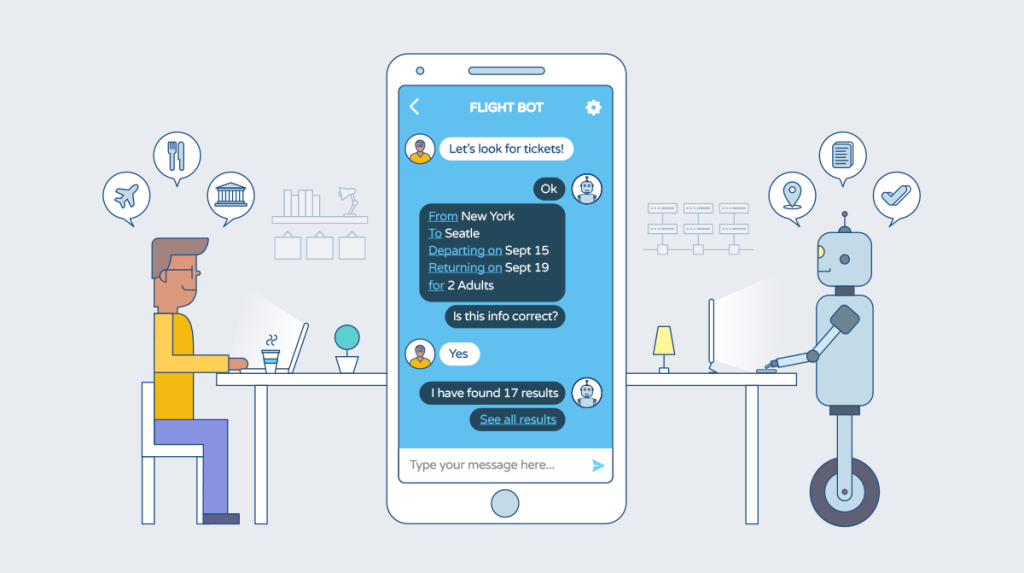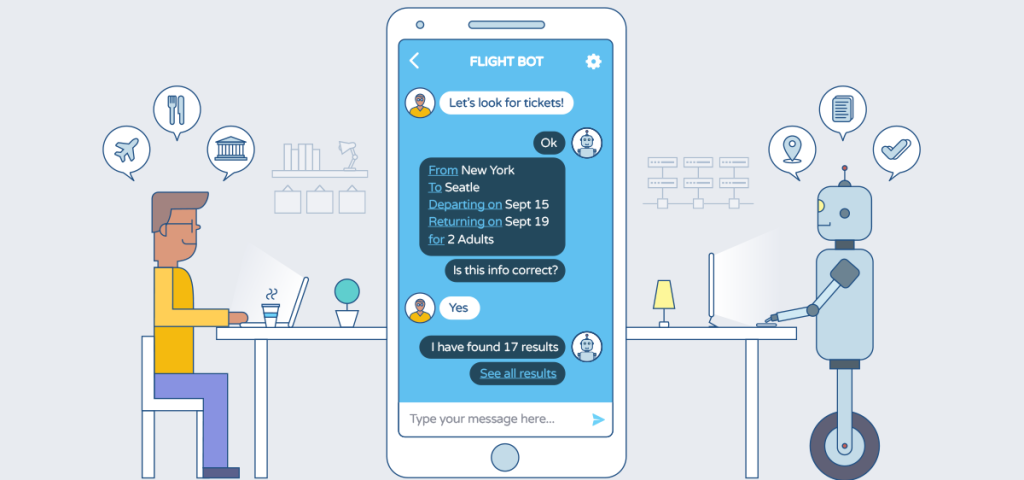The chatbot industry is worth $137.6 million in 2023. It’s predicted that its value will be $239.2 million by 2025.

In today’s digital world, businesses desire innovative ways to engage customers and streamline their operations. One such technological advancement that has gained significant momentum is chatbots.
Chatbots, powered by artificial intelligence (AI), have transformed businesses’ interaction with their customers, providing seamless and personalized experiences around the clock.
In this blog, we will explore the incredible capabilities of chatbot web development and how they can revolutionize your business.
What are Chatbots?
Chatbots, or conversational agents, are AI-powered software programs designed to simulate human-like conversations with users. They leverage natural language processing (NLP) and machine learning algorithms to understand user queries and provide relevant responses.
Chatbots are deployed across various platforms, including websites, messaging apps, social media platforms, and voice assistants. You can also create a chatbot for your website using coding.
What is the importance of Chatbots?
Enhancing Customer Experience
a. Instantaneous Support: One of the primary advantages of chatbots is their ability to provide instant customer support. Unlike traditional customer service channels, which may have long wait times, chatbots offer real-time assistance, resolving queries and issues promptly. This leads to improved customer satisfaction and loyalty.
b. 24/7 Availability: Chatbots operate round the clock, enabling businesses to provide support outside regular working hours. Customers can access information and assistance calmly, regardless of time zones or geographical location. This availability significantly enhances customer experience and ensures businesses never miss an opportunity to engage with their audience.
c. Personalization: Advanced chatbots can analyze user data and behavior patterns to deliver personalized experiences. By understanding customer preferences and purchase history, chatbots provide relevant products or services, provide tailored suggestions, and offer a more personalized interaction overall. This level of customization strengthens the customer-business relationship and drives sales.
Applications of Chatbots
a. Customer Service: Chatbots are widely used in customer service to handle common inquiries, provide product information, and assist with troubleshooting. They can quickly retrieve information from databases, guide users through processes, and escalate complex issues to human agents when necessary. This saves time for customers and support teams, resulting in efficient and effective customer service.
b. E-commerce: Chatbots are transforming the e-commerce landscape by offering personalized shopping experiences. They can assist customers in finding products, processing orders, and tracking shipments. Additionally, chatbots can provide recommendations based on user preferences, previous purchases, and browsing history, increasing cross-selling and upselling opportunities.
c. Lead Generation and Sales: Chatbots are valuable tools for lead generation and sales conversion. By engaging visitors, chatbots can qualify leads, answer questions, and provide relevant information to guide potential customers through the sales funnel. They can even initiate proactive conversations and offer discounts or promotions to incentivize purchase decisions.
Types of chatbots
There are numerous chatbots are available, each designed to serve specific purposes and cater to different user needs. Here are some common types of chatbots:
Rule-Based Chatbots:
Rule-based chatbots, scripted or decision-tree chatbots, follow a predefined set of rules and responses. They are programmed with a series of if-then statements or rules that determine their behavior. These chatbots can handle simple interactions but may struggle with complex queries or unpredictable user inputs.
AI-Powered Chatbots:
AI-powered chatbots leverage artificial intelligence and machine learning algorithms to understand and respond to user queries. They use natural language processing (NLP) to interpret user intent, extract relevant information, and generate contextually appropriate responses. AI-powered chatbots can handle more complex conversations and learn from user interactions to improve their performance over time.
Virtual Assistants:
Virtual assistants are advanced chatbots designed to provide personalized assistance and perform tasks on behalf of users. They can handle multiple tasks, such as answering questions, scheduling appointments, making reservations, providing recommendations, and executing actions through integration with other systems or APIs. Virtual assistants like Siri, Alexa, and Google Assistant fall into this category.
Transactional Chatbots:
Transactional chatbots focus on facilitating transactions and completing specific tasks. They are common in e-commerce and customer service scenarios. These chatbots can help users make purchases, track orders, process payments, and provide relevant information about products or services. Transactional chatbots aim to streamline and simplify transactional processes for users.
Social Media Chatbots:
Social media chatbots operate within messaging platforms and social media networks. They enable businesses to engage with users and provide customer support through platforms like Facebook Messenger, WhatsApp, or Twitter. Social media chatbots can handle inquiries, provide information, and even initiate user conversations based on predefined triggers or user interactions.
Voice-Enabled Chatbots:
Voice-enabled chatbots, voice assistants, or voice bots, interact with users through voice commands and responses. These chatbots leverage voice recognition technology and natural language understanding to comprehend user speech by providing relevant information or performing requested tasks. Voice-enabled chatbots are available in devices like smart speakers, mobile phones, and in-car systems.
Hybrid Chatbots:
Hybrid chatbots combine the capabilities of rule-based chatbots and AI-powered chatbots. They use a combination of predefined rules and machine learning algorithms to respond. Hybrid chatbots can handle a wide range of user queries and adapt to new situations while still relying on predefined rules for specific scenarios.
It’s worth noting that these categories are not mutually exclusive, and chatbots can incorporate features and functionalities from multiple types, depending on the requirements of the business or application. The choice of chatbot type depends on factors such as the complexity of interactions, the desired level of personalization, and available resources for development and maintenance.
Chatbot Benefits Statistics
- According to Drift, chatbots are designed to provide 24/7 customer support regardless of geographical location or time zone, ensuring round-the-clock service availability.
- IBM suggests that businesses can save up to 30% in total costs by replacing potential chat support workers with chatbots, thus reducing the need for human resources and associated expenses.
- Drift found that approximately 42% of potential customers utilize chatbots when making online purchases, as chatbots provide a seamless and doubt-free service experience.
- Kindly report that chatbots achieve an impressive 80% customer satisfaction rate due to their programming that aims to deliver accurate and reliable results.
- According to a survey conducted by User Like, most customers prefer chatbots over human corporate agents when it comes to resolving queries and obtaining assistance.
These statistics underscore the positive impact of chatbots in enhancing customer satisfaction, reducing costs, and delivering consistent and reliable support to businesses across various industries.
The Future of Chatbots
a. Advancements in AI: As artificial intelligence technology grows, chatbots become increasingly sophisticated. Machine learning algorithms enable chatbots to learn from interactions, adapt to user preferences, and improve their responses over time. Natural language understanding is also improving, allowing chatbots to comprehend and respond to complex queries accurately.
b. Voice-Enabled Chatbots: With the rising popularity of voice assistants like Siri, Alexa, and Google Assistant, voice-enabled chatbots are gaining prominence. These chatbots enable users to engage in conversational interactions via voice commands, providing a hands-free and intuitive experience. Voice-enabled chatbots have numerous applications, ranging from virtual assistants to smart home automation.
Conclusion
In an era where customer expectations are soaring, businesses are required to embrace innovative solutions to stay ahead of the curve. Werq Labs offers state-of-the-art chatbot development services that harness the power of artificial intelligence, natural language processing, and machine learning to create intelligent and efficient conversational bots.
By partnering with Werq Labs, businesses can automate routine tasks, improve customer engagement, and unlock new growth opportunities. Don’t miss the chance to revolutionize your customer interactions and explore the full potential of chatbot technology with Werq Labs.
